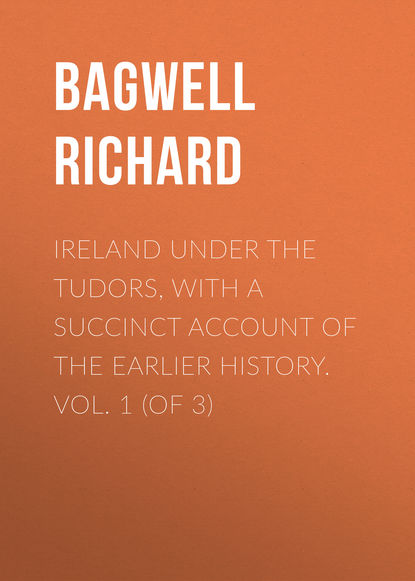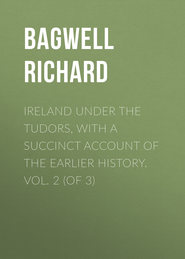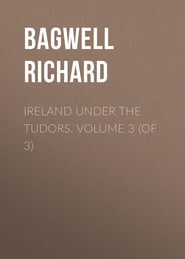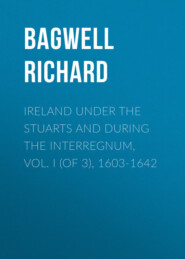По всем вопросам обращайтесь на: info@litportal.ru
(©) 2003-2024.
✖
Ireland under the Tudors, with a Succinct Account of the Earlier History. Vol. 1 (of 3)
Настройки чтения
Размер шрифта
Высота строк
Поля
Sussex had left Leix and Offaly in confusion, and he returned to find them in the same state, his brother, Sir Henry Radecliffe, being actually besieged in Maryborough by the natives, under Donogh and another O’Connor, accompanied by Richard Oge, one of the bastard Geraldines who had so long been troublesome. The garrison beat off their assailants after a hard fight, Richard Oge falling by the hand of Francis Cosby; but Donough again escaped. The first matter which demanded the personal attention of Sussex after his return was the state of Thomond, where Sir Donnell More O’Brien – who had slain his brother, the second Earl, five years before – was now disputing the title of his young nephew Connor, whose principal castles he held. Ormonde, whose aunt was the young lord’s mother, was of course interested in his favour, and the same reason was enough to make Desmond incline to Sir Donnell. It became necessary for Sussex himself to go in force and establish some kind of order. Taking the familiar line through Offaly and Ely, Leap Castle being abandoned at their approach, the Lord Deputy and his troops, strengthened on the route by the adhesion of Barnaby Fitzpatrick and a considerable force, marched across North Tipperary by Newport and Cahirconlish to Limerick, which was reached on the seventh day after leaving Dublin. At a point a few miles from the city Ormonde and his brother Edmund appeared with a large party. The young lord of Cahir, Gerald the heir of Desmond, with all the forces of his house, MacCarthy More, who received the honour of knighthood and a gold chain and gilded spurs, and William Burke, chief of the district, joined on the same day. At the gate of Limerick the mayor and aldermen in scarlet robes delivered to Sussex the keys and mace, which he returned to the mayor. With the civic insignia and sword of state borne before him, the Lord Deputy rode to the door of the cathedral, where the Marian bishop, Hugh Lacy, met him, and where he was censed and sprinkled with holy water. Sussex kissed the cross both here and at the rood, where the same ceremonies were repeated, and knelt devoutly at the high altar while the Te Deum was sung. Salutes were fired after church.
The Desmonds at Limerick
The Lord Deputy rested ten days at Limerick, during which time was performed the rite of ‘bishoping’ Desmond’s youngest child, the old Earl being present himself. This was a first or second baptism, for the little Fitzgerald was not old enough to be confirmed, and the Lord Deputy stood sponsor and gave his god-child his own name, and presented him at the same time with a gold chain. The career of James Sussex Fitzgerald thus auspiciously begun was destined to end in a traitor’s death on the scaffold.
The O’Briens
Sir Donnell O’Brien failed to appear, and was thrice proclaimed traitor at Limerick. Sussex then issued forth into Thomond. Clare Castle and Ennis made no resistance, but a few cannon shot had to be fired at Bunratty before it surrendered. The Earl of Thomond, having been placed in possession of his country, was sworn upon the sacraments and on the relics of the Church with bell, book, and candle, to forsake the name of O’Brien, and to be true to the King and Queen. All the freeholders of the district swore in the same solemn way to obey him as their captain.
O’Shaughnessy
On his journey westward from Limerick, Sussex spent a night with O’Shaughnessy at Gort, where he ‘dined so worshipfully as divers wondered at it, for the like was not seen in an Irishman’s house.’ At Galway he was received with the same civic, military, and religious ceremonies as at Limerick, and, after staying four or five days, returned by Athenry and Meelick into Offaly, and thence to Dublin.[420 - This tour is in Carew, i. 274-277; the date in the end of July 1558.]
Expedition against the Hebridean Scots. It ends in failure
Sidney’s apprehensions were partially realised, for James MacDonnell landed before Sussex with 600 islemen and two guns. But Carrickfergus had been reinforced, and the greater part of the Scots returned to their own country. Colla MacDonnell, one of the chief’s five brothers and the resident guardian of his clan’s Irish interests, died soon afterwards, and, his brother Angus having refused to take his place, Sorley Boy, the youngest and ablest of the family, filled the vacant post. It was decided to attack the Redshanks in their own islands, and a fleet assembled at Lambay from which great things were evidently expected. Sussex urged despatch; but the delays of the supply service were inveterate, and nothing was done for nearly three weeks. The Lord Deputy landed first in Cantire, and began operations by burning James MacDonnell’s ‘chief house called Sandell, a fair pile and a strong.’
The fleet is in danger,
He boasted that in three days he burned everything from sea to sea in a district twenty miles long, and this without meeting any opposition worth notice. Isla was the great object of the expedition; but the wind was unfavourable, and the incendiary’s work could be carried on elsewhere. Arran was accordingly devastated, the army dividing into two, so as to make the damage more complete. Isla being still inaccessible, the same fate was intended for Bute, but just as the boats were about to be manned a sudden gale sprung up, ‘and that being then the weather shore the wind wheeled suddenly and made it the lee shore, whereby we being very near the shore were forced to ride it out for life and death in such a place as if any tackle had slipped or broken the ship whose tackle had so slipped or broken must needs have perished.’ The cable of a Dublin transport parted, and she foundered with a loss of twenty-eight men. Most of the small vessels got into harbour, ‘but the masters of H.M.’s ships I think thought scorn thereof.’ The fine gentlemen who commanded men-of-war in those days were unwilling to take advice from the old seamen who acted as their sailing masters or pilots. With loss of boats, running rigging, and anchors, the fleet escaped, and the captains, whose courage was ‘somewhat cooled,’ were content after this to be controlled by their professional associates.
and is forced to retire
The poor little Cumbrays having been ravaged, the disabled vessels were just able to reach Carrickfergus after a dead beat against a stiff north-wester. Sussex landed, and was nearly lost in regaining his flag-ship, the ‘Mary Willoughby.’ A council of war was then held, and it was found that there were provisions for only three weeks more, and that damages could not be properly repaired in Ireland. Only three ships were at all fit for service; and, moreover, ‘the new bark is a ship of such length and unwieldliness in steerage as she is not to be ventured among the isles in such stormy weather, where there be many deep and narrow channels and strong tides.’ It was feared that the ships might be becalmed or otherwise delayed in the isles, there was now no spare tackle in case of future storms, and it was by no means impossible that the crews and troops might starve. The hope of visiting Isla was therefore abandoned, and Sussex landed the soldiers with the less ambitious intention of attacking the Scots in the Route. An English fleet and army carefully equipped and commanded by many gallant gentlemen had just succeeded in burning some barren islands, not without considerable loss to themselves, and had returned disabled without striking a blow. Sussex was conscious of his failure, and begged the Queen ‘not to impute any lack in me, but to consider that whatever I wrote of was feasible, is feasible, and shall with grace of God be put in execution with a great deal more than I wrote of,’ &c. The expedition is not even noticed in the Scots correspondence of the time, nor was anything done to retrieve matters on land. Out of 1,100 soldiers, but 400 were fit for service, the rest being prostrated by illness caused by the foul water on board ship.[421 - For the expedition to the isles, see Sussex to the Queen, Oct. 3, Oct. 6, and Oct. 31, 1558.]
Activity of Sussex. He leaves Ireland at Mary’s death
Want of activity at least could not be charged against Sussex, who carried out strictly the spirit of the Queen’s instructions, which desired him to be constantly on the move. He was at Leighlin a few days after his return from Scotland, and then returned to Dublin, where the affairs of Munster occupied his attention. The old Earl of Desmond was dead, and his son Gerald, destined to a disturbed life and a miserable death, succeeded to the splendid but troublesome inheritance of the Southern Geraldines. He promised fair, and was knighted by the Lord Deputy’s hands, who went to Waterford to receive his homage and to admit him to the earldom. Sir Maurice Fitzgerald of Decies, who ruled about one half of the county of Waterford, also made his submission, promising to obey the law and make others obey it, to give his help to all judges, commissioners, and tax-gatherers, and to secure free admission for all to the markets at Waterford, Dungarvan, and elsewhere. The news of Mary’s death reached Ireland soon after this, and Sussex, who had already obtained leave to go to England, hurried away to pay his court to the new sovereign. He left Ireland tolerably quiet.[422 - Journeys by the Earl of Sussex, July and Nov. 1558, in Carew; oath of Gerald Earl of Desmond, Nov. 28.]
Story as to an intended Marian persecution in Ireland
Mary did all she could to efface her father’s anti-Roman policy; but no Irish persecution took place. This may have been less from the Queen’s want of will than from the insignificance of the Protestants in Ireland. It is said that many people fled from the western parts of England in hope of sharing the comparative immunity enjoyed by the small Protestant congregation in Dublin. One story seems to show that this had attracted attention, and that Dublin would not have long escaped. It rests on the testimony of Henry Usher, one of the fathers of Trinity College and afterwards Archbishop of Armagh, and was repeated by his more famous nephew James Usher, and by other public men of repute. Henry Usher died at a great age in 1613, and was Treasurer of St. Patrick’s as early as 1573. In the absence of anything to rebut it, such evidence can hardly be rejected. The story is that a Protestant citizen of Dublin named John Edmonds had a sister living at Chester married to one Mattershed, who kept an inn or lodging-house in which Cole, Dean of St. Paul’s, slept when on his way to purge the Irish Church. ‘Here,’ said Cole, in the hearing of his hostess, ‘is a commission that shall lash the heretics of Ireland.’ The good woman watched her opportunity, possessed herself of the doctor’s wallet, and substituted a pack of cards for the commission – a service for which she received a pension of 40l. from Queen Elizabeth. On reaching Dublin, Cole went straight to the Castle, where the Lord Deputy, who had just returned from his Scotch expedition, was sitting in council. Cole declared his business in a set speech; but when the secretary opened his wallet he found only the cards, with the knave of clubs uppermost. Sussex had conformed to the dominant creed, but had probably no wish to be a persecutor, and may have rejoiced at Cole’s discomfiture. ‘Let us have another commission,’ he said, ‘and we will shuffle the cards in the meanwhile.’ A new scourge for the heretics was despatched, but before it came to hand Mary’s unhappy career had closed.[423 - Ware’s Life of Browne. In their instructions to the Lord Deputy and Council, Philip and Mary say: – ‘Lord Cardinal Poole, being sent unto us from the Pope’s Holiness and the said See Apostolic Legate of our said realms, mindeth in brief time to despatch into Ireland certain his commissioners and officials to visit the clergy and other members of the said realm of Ireland,’ &c., Carew, April 28, 1556.]
Death of Mary and Reginald Pole
The weak enthusiast who, far more than Gardiner or Bonner, must share the responsibility for the persecution with which this Queen’s name is inseparably connected, was not long divided from her in death. Reginald Pole survived his kinswoman some twenty-two hours, and almost the last sounds to reach his ears were the cheers with which a people that breathed freely once more greeted the accession of Queen Elizabeth.
END OF THE FIRST VOLUME
notes
1
As to the divisions and sub-divisions of the ancient Irish people, I prefer to give the following statement of Dr. Sullivan: – ‘The unit territory was the Tuath, each of which had a Ri, or chief. Three, four, or even more Tuatha were connected together for military and other purposes as a Mór Tuath; the king or chief of the confederacy, who acted as Commander-in-Chief, was the Ri Mór Tuatha, or great chief. This group corresponded to the Gothic Thiuda, old Norse Thjoth. The Irish unit Tuath corresponded to the Norse Fylk, the Teutonic Gavi or Gau, the Greek Phyle, and the old Latin Tribus; it was at first genealogical, but acquired a geographical and political signification. The tribe or Tuath consisted in some cases of a Clann, the progeny or descendants of a chief. Sometimes a Clann embraced several Tuatha. Clann was strictly genealogical, Tuath both genealogical and geographical. The Clann consisted of families or houses called Fine, equivalent to Cognatio– the Anglo-Saxon Maegth. The head of a Fine was the Cendfinne or chieftain. The Fine was a sept. The Clann therefore consisted of several septs, and the land of the tribe or Tuath was divided between the septs or Fine composing it. The Fine or sept is one of the most important parts of the Irish organisation, but the word is used in several senses: thus, the relatives of a chief or other tribesman to the fifth degree constituted the true Cognatio or Geilfine, i.e. Hand-fine. The Fine or sept was in fact an independent unit, which paid Erics for all its members, and received Erics or fines for the killing of one of its own members, and also took possession of the Dibad or property of its deceased members. But when the sept did not fulfil its obligations, the Ri of the Tuath was bound to enforce justice. So when the Tuath itself failed in its obligations and duties, the Ri Mór Tuatha or superior chief was bound to enforce justice in the recalcitrant tribe. The Ri Mór Tuatha, or Ri buiden, or king of companies, corresponded to the Anglo-Saxon Heretoga or Dux. The King of the Great Tribe received hostages from the sub-reguli of his territory for their Ceílsine or fealty, and he might call upon them to support him with a levy of their tribes.’
2
‘The existence of the Irish Pentarchy,’ says Dr. Sullivan, ‘was as real as that of any similar confederacy among nations in a tribal stage, and the means of enforcing the orders of the over-king were not very different or less effective than in many federal states – ancient, mediæval, and modern.’
3
‘It is quite true,’ says Dr. Sullivan, ‘that the central power was not always strong enough to enforce rights, and in many instances was defeated in its attempt to do so. But in what does this differ from other federal states, ancient and modern? The Emperors of Germany were not always able to subdue and to enforce their decrees against the princes and nobles of the Empire, and in numerous instances the decisions of the imperial chancery might be regarded in precisely the same light – as mere arbitrations. To say there was no law, properly speaking, seems to me wholly irreconcilable with actual facts, and especially with the existence of a rich and elaborate nomenclature of native terms not borrowed from Roman law. This nomenclature implies an equally elaborate machinery. It was the existence of this legal system which kept out the canon law, which never, for instance, succeeded in suppressing or even modifying the marriage customs. In discussing the laws and institutions of early nations we are liable to go to one or other of two extremes: – (1) We represent the laws, &c., in terms of modern law, by which we make inchoate institutions full-grown, while the germs of a legal system are represented as a fully developed code; or (2) we deny the existence of all law and legislation. You are right I think as regards the Church; for owing to the organisation of the old Celtic Church it was perfectly acephalous. Whatever influence it did exert was individual and never official, and, therefore, not continuous – it might be described in fact as sporadic influence.’
4
‘All through the laws,’ says Dr. Sullivan, ‘there is ample evidence to prove that the tribesmen, or Aires, were bound to take stock from the Ri, or chief, only. The amount of this stock, called Saer, or free-stock, is strictly laid down, and the amount of the tribute payable for this stock, called Bestigi, or house-refection, or tribute, is also strictly laid down. But if the Ri were wealthy he might offer more stock to his Ceiles, clients or vassals, on condition of paying him certain dues, called Biatad. The stock so given was called Daer, or base-stock; and its acceptance by a tribesman made a Daer-ceilé of him, and placed him very much in the power of the Ri, or chief. No tribesman could accept Daer-stock without the consent of his Fine, or sept, which would be bound by the acts of its members. A tribesman, with the consent of his Fine, might accept Daer-stock from any Flath, or lord, in his own Tuath, or tribe. All the above applies to the tribesmen, or Aires, who alone constituted the free class. But besides the Ceiles, or clients, or free tribesmen, or Aires, there was another class, called Fuidirs. The markland of the tribe and the land held in severalty of the Ri, and the similar land of the Cendfinne, or chieftain (or captain, as he is called in the Scottish Highlands) of a sept was let out to various classes of Fuidirs. Some were Saer, or free Fuidirs, and others Daer, or base Fuidirs. The Saer-fuidirs, again, were of two sorts – broken tribesmen who went into another Tuath and got stock as well as land from a Ri, or Flath, and Saer-fuidirs who possessed some stock of their own which they grazed on land of a chief or of a Flath. Some of these free Fuidirs entered into daer, or servitude, by accepting stock under certain conditions. The Fuidir classes were the true tenants at will. The Aires were of the clan, the Fuidirs, Bottachs, or cottiers, and other servile classes, belonged to the clan. The giving and taking of Daer-stock depended upon the impoverishment of a sept through cattle murrain, the levying of blood-fines on account of the misconduct of some of its members, &c. But the whole thing was voluntary, and depended on the poverty of a sept and the wealth and ability of the Ri, or Flath.’
5
Dr. Sullivan does not think Christianity was fully established by the middle of the seventh century. ‘The Irish Church organisation,’ he says, ‘was ill calculated to influence the social habits and the political life of the people; unlike the diocesan and centralised system of the Latin Church. Hence a high spiritual life and intellectual cultivation within the numerous cœnobiums was quite compatible with practical paganism and disorder outside.’
6
‘At all times’ must be understood to refer only to those comparatively modern ages above mentioned.
7
‘The election,’ says Dr. Sullivan, ‘was always from the Geilfine, or relatives within the fifth degree. Should the Geilfine fail, or be all killed in battle, the Derbfine, or relatives from the fifth to the ninth degree, came in.’
8
‘This,’ says Dr. Sullivan, ‘is not right. There was the “joint undivided family” formed by the Bo-aire class, or freemen possessed of cattle. The poorer Flaths, or heads of septs, did not gavel their possessions, but either elected a tanist or formed a “joint undivided family.” When the property of an Aire was not sufficient to gavel, so as to qualify one or more Aires, the division of the inheritance did not take place, but the parties agreed to form a “joint undivided family.” In such a family one was head, and as such was an Aire. Bo-aires of this class, to avoid the gavelling of their property, elected a Tanist– the Tanaise Bo-aire. Poor and broken tribesmen, not having sufficient wealth to qualify them as Aires, formed a “joint-family,” or Congilda. Every Flath, or head of a sept, had a tanist also. The Irish “joint-family” was an institution of great importance and of surpassing interest in the comparative history of the Aryan family.’
9
‘This account of Davies,’ says Dr. Sullivan, ‘is entirely wrong. The law of the distribution of the property of a deceased tribesman was most carefully laid down. No doubt then as now, and naturally more frequently then than now, a chief, or head of a sept, or of a Treb (homestead) might usurp power he did not possess, and do wrong.’
10
‘Marriages in Ireland,’ says Dr. Sullivan, ‘were not regulated by canon law. The Irish marriage customs were in full force long after the Norman conquest. According to these customs, which appear to have been wholly uninfluenced by the canon law, bastardy was entirely different from what that term implied in countries under canon law, and in modern times. The Irish marriage customs should consequently be taken into account here, as they sanctioned a kind of polygamy, divorce, &c. See also the excommunication in 1282, by the Archbishop of Canterbury against Llewellyn, Prince of Wales, at the request of Edward I., in which the marriage customs of the Welsh, identical with those of the Irish, constitute one of the charges.’
11
Le Résolution des justices touchant le Irish custome de gavelkind. Reported by Sir John Davies, A.G., 3 Jac. i.
12
Dr. Sullivan believes the story of the decision against Columba to be a mere myth.
13
‘The Irish Church,’ says Dr. Sullivan, ‘had undoubtedly two distinct phases of monasticism: one that of the Patrician period – an obscure but highly important and interesting phase; the other, that of the sixth and subsequent centuries, to which the Irish missionaries belonged.’
14
‘Besides,’ says Dr. Sullivan, ‘the monastic bishop proper, who furnished the wandering Scotic bishops of the Middle Ages, there is a later development of a higher church organisation in the tribal bishop, who was a close approximation to a diocesan bishop. The tribal bishop was a bishop who had jurisdiction over the whole of a Tuath, and sometimes even a Mór Tuath. The growth of territorial jurisdiction is well marked by the prestige attached to the office – the bishop ranked in fact almost on a level with the chief, and was entitled to the same legal retinue. Many of the ancient dioceses, and some of the existing ones, e. g. Ross, Kilmacduagh, Kilfenora, represent ancient Tuaths, or tribe territories. Several deaneries were former dioceses, and are co-extensive with ancient Tuatha.
15








